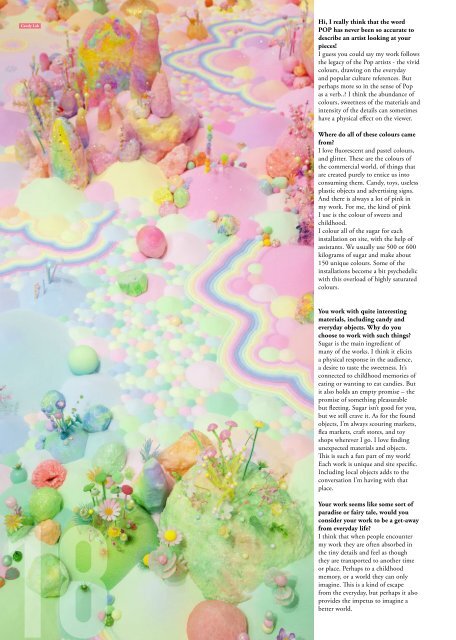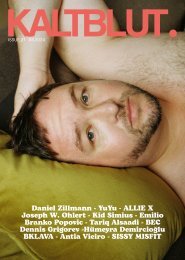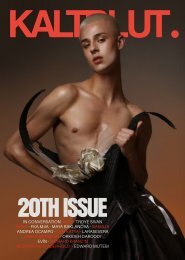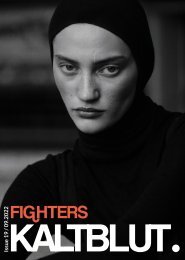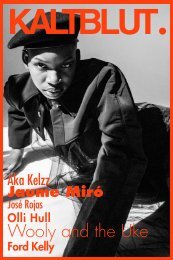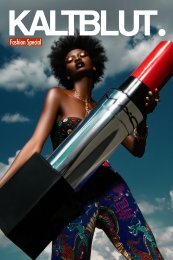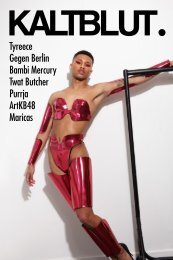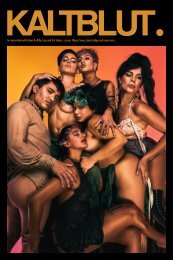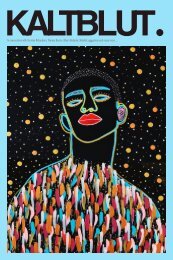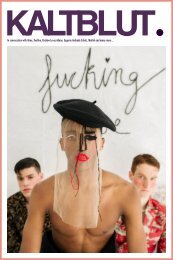POP CULTURE! Issue
Happy birthday to us!! We are celebrating 4 years of KALTBLUT Magazine with our new print issue. 120 Pages featuring artists like Candy Ken, Years & Years, Mykki Blanco, Pip & Pop, Crystal, Patrick de Padua, Strawberry Bubblegums, Aminata, Maisie Cousins .. Plus fashion editorials, interviews, new rubrics, essay and more. Special THX to Negroni.
Happy birthday to us!! We are celebrating 4 years of KALTBLUT Magazine with our new print issue. 120 Pages featuring artists like Candy Ken, Years & Years, Mykki Blanco, Pip & Pop, Crystal, Patrick de Padua, Strawberry Bubblegums, Aminata, Maisie Cousins .. Plus fashion editorials, interviews, new rubrics, essay and more. Special THX to Negroni.
You also want an ePaper? Increase the reach of your titles
YUMPU automatically turns print PDFs into web optimized ePapers that Google loves.
Candy Lab<br />
Hi, I really think that the word<br />
<strong>POP</strong> has never been so accurate to<br />
describe an artist looking at your<br />
pieces!<br />
I guess you could say my work follows<br />
the legacy of the Pop artists - the vivid<br />
colours, drawing on the everyday<br />
and popular culture references. But<br />
perhaps more so in the sense of Pop<br />
as a verb..? I think the abundance of<br />
colours, sweetness of the materials and<br />
intensity of the details can sometimes<br />
have a physical effect on the viewer.<br />
Where do all of these colours came<br />
from?<br />
I love fluorescent and pastel colours,<br />
and glitter. These are the colours of<br />
the commercial world, of things that<br />
are created purely to entice us into<br />
consuming them. Candy, toys, useless<br />
plastic objects and advertising signs.<br />
And there is always a lot of pink in<br />
my work. For me, the kind of pink<br />
I use is the colour of sweets and<br />
childhood.<br />
I colour all of the sugar for each<br />
installation on site, with the help of<br />
assistants. We usually use 500 or 600<br />
kilograms of sugar and make about<br />
150 unique colours. Some of the<br />
installations become a bit psychedelic<br />
with this overload of highly saturated<br />
colours.<br />
You work with quite interesting<br />
materials, including candy and<br />
everyday objects. Why do you<br />
choose to work with such things?<br />
Sugar is the main ingredient of<br />
many of the works. I think it elicits<br />
a physical response in the audience,<br />
a desire to taste the sweetness. It’s<br />
connected to childhood memories of<br />
eating or wanting to eat candies. But<br />
it also holds an empty promise – the<br />
promise of something pleasurable<br />
but fleeting. Sugar isn’t good for you,<br />
but we still crave it. As for the found<br />
objects, I’m always scouring markets,<br />
flea markets, craft stores, and toy<br />
shops wherever I go. I love finding<br />
unexpected materials and objects.<br />
This is such a fun part of my work!<br />
Each work is unique and site specific.<br />
Including local objects adds to the<br />
conversation I’m having with that<br />
place.<br />
18<br />
Your work seems like some sort of<br />
paradise or fairy tale, would you<br />
consider your work to be a get-away<br />
from everyday life?<br />
I think that when people encounter<br />
my work they are often absorbed in<br />
the tiny details and feel as though<br />
they are transported to another time<br />
or place. Perhaps to a childhood<br />
memory, or a world they can only<br />
imagine. This is a kind of escape<br />
from the everyday, but perhaps it also<br />
provides the impetus to imagine a<br />
better world.


